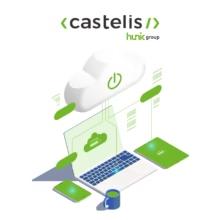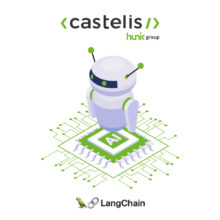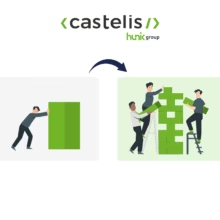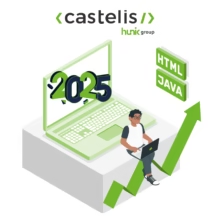
What is Green IT?
Green IT, or responsible digital technology, refers to all practices aimed at reducing the environmental impact of digital technology, from the design of solutions to all stages of their lifecycle.
The actions implemented all point in the same direction: reducing the quantity of resources needed to produce and use a service. In this way, we limit consumption, and therefore the manufacture of superfluous resources, and we extend the life of devices, which represent the majority of the impact of digital technology.
Manufacturing and power consumption
Sources of environmental impact
Concretely, the sources of environmental impact are distributed as follows :
- Manufacturing and electrical consumption of equipment (47%)
- Power consumption and network infrastructure manufacturing (28%)
- Electrical consumption of data centers and equipment manufacturing (25%)
On its own scale, Castelis is able to intervene on the electrical consumption of equipment and infrastructures.

Environmental impact of digital technology
According to studies and reports by Ademe, the Shift Project, and the Green IT collective, the impact of digital technology on the environment is considerable, both during the production of solutions and during their operation.
However, applying simple measures such as reducing the number of connected objects in favor of sharing and open APIs; replacing screens with less energy-consuming display devices such as VR/AR or LED projectors; extending the lifespan of terminals and fighting against programmed obsolescence; or eco-design of digital solutions, would have made it possible to reduce the global carbon footprint of digital technology by 27% to 52% between 2010 and 2025, keeping it at its 2018 level despite 1.1 billion new users.
Share of digital equipment and infrastructure in electricity consumption in France
Estimated share of digital technology in France's GHG emissions by 2040 based on the current model
Increase in energy consumption for digital technology each year
The challenges of digital responsibility for companies
Convincing economic arguments
Beyond environmental considerations, companies also have compelling economic arguments to take the green IT turn as soon as possible.

Reduce operating costs
An eco-designed software or application is less energy consuming, reducing expenses in electricity, network infrastructure, power and cooling of servers... They also allow to increase the life span of the equipments and thus to limit and space the investments.

Anticipating regulations
Green IT initiatives are increasingly accompanied by a desire for standardization. Also, the reflection on the carbon debt of companies, for example, suggests that future regulations will be more restrictive than the current voluntary approaches.

Secure a competitive advantage
A website or a web application that is more virtuous is more valuable than the competition. With the emergence of labels such as Green Code Label, companies are becoming more aware of Green IT issues and favor less energy-consuming solutions.

Boosting performance
The less energy a digital service consumes, the better it performs. It loads faster, creates a more positive user experience, is better referenced by search engines and therefore generates more business, meeting marketing and sales objectives.

Improve brand image
A company that is concerned about its environmental impact and relies on concrete and measurable actions can communicate its results as part of its CSR approach. It therefore attracts new partners and customers, builds loyalty among existing ones and attracts new talent.
Reducing the carbon footprint at Castelis
Acting on a daily basis
Castelis’ actions to reduce its environmental impact are not new and do not only concern Green IT. This is evidenced by the latest CSR reports.
- Sorting and recycling of waste, including computer waste;
- Division by three of the quantity of paper used;
- Responsible use of heating and air conditioning;
- Dematerialization of paper and digitalization of work tools;
- Use of ecological household products…
On the web side, employees are made aware of good practices in all departments :
- Reduction of the number and weight of emails;
- Optimization of the performance of internal software;
- Choice of less energy consuming cloud servers;
- Purchase of less energy consuming hardware, even second hand…

Green IT, where does Castelis stand?
Castelis has been progressively developing its knowledge for a responsible digital environment for several years. The teams, both for the infrastructure offers and for the custom development, regularly adopt new practices.
Recently, the company has committed itself to a training and certification process in order to develop its skills in eco-design and reduce the energy consumption of the solutions offered to its customers.
Contact-us
News
Discover all the information about the Castelis team, its products and services as well as the next events to come !



